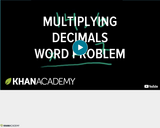
In the 1920s, assembly line production and easy credit made it possible for ordinary Americans to purchase many new consumer goods.
- Subject:
- History
- Material Type:
- Reading
- Provider:
- Khan Academy
- Date Added:
- 03/22/2024

In the 1920s, assembly line production and easy credit made it possible for ordinary Americans to purchase many new consumer goods.

To add the vectors (x₁,y₁) and (x₂,y₂), we add the corresponding components from each vector: (x₁+x₂,y₁+y₂). Here's a concrete example: the sum of (2,4) and (1,5) is (2+1,4+5), which is (3,9). There's also a nice graphical way to add vectors, and the two ways will always result in the same vector.

This site teaches Arithmetic with Polynomials and Rational Expressions to High Schoolers through a series of 4333 questions and interactive activities aligned to 26 Common Core mathematics skills.

This site teaches High Schoolers how to create equations through a series of 298 questions and interactive activities aligned to 5 Common Core mathematics skills.

This site teaches Reasoning with Equations and Inequalities to High Schoolers through a series of 5909 questions and interactive activities aligned to 36 Common Core mathematics skills.

This site teaches Structure in Algebraic Expressions to High Schoolers through a series of 3482 questions and interactive activities aligned to 26 Common Core mathematics skills.

This arithmetic lesson demonstrates more long division problems with remainders.[Arithmetic playlist: Lesson 26 of 38]

You get the general idea of decimal is and what the digits in different places represent (place value). Now you're ready to do something with the decimals. Adding and subtracting is a good place to start. This will allow you to add your family's expenses to figure out if your little brother is laundering money (perhaps literally). Have fun! Common Core Standard: 5.NBT.B.7

You get the general idea of decimal is and what the digits in different places represent (place value). Now you're ready to do something with the decimals. Adding and subtracting is a good place to start. This will allow you to add your family's expenses to figure out if your little brother is laundering money (perhaps literally). Have fun! Common Core Standard: 5.NBT.B.7

You get the general idea of decimal is and what the digits in different places represent (place value). Now you're ready to do something with the decimals. Adding and subtracting is a good place to start. This will allow you to add your family's expenses to figure out if your little brother is laundering money (perhaps literally). Have fun! Common Core Standard: 5.NBT.B.7

In this tutorial, we'll extend our division skills to include decimals! Common Core Standard 5.NBT.B.7

In this tutorial, we'll extend our division skills to include decimals! Common Core Standard 5.NBT.B.8

In this tutorial, we'll extend our division skills to include decimals! Common Core Standard 5.NBT.B.9

In this tutorial, we'll extend our division skills to include decimals! Common Core Standard 5.NBT.B.10

In this tutorial, we'll extend our division skills to include decimals! Common Core Standard 5.NBT.B.11

Let's learn to divide any whole number by any other! Common Core Standard: 5.NBT.B.6

Let's learn to divide any whole number by any other! Common Core Standard: 5.NBT.B.7

The real world is seldom about whole numbers. If you precisely measure anything, you're likely to get a decimal. If you don't know how to multiply these decimals, then you won't be able to do all the powerful things that multiplication can do in the real world (figure out your commission as a robot possum salesperson, determining how much shag carpet you need for your secret lair, etc.). Common Core Standards: 5.NBT.B.5, 5.NBT.B.7

The real world is seldom about whole numbers. If you precisely measure anything, you're likely to get a decimal. If you don't know how to multiply these decimals, then you won't be able to do all the powerful things that multiplication can do in the real world (figure out your commission as a robot possum salesperson, determining how much shag carpet you need for your secret lair, etc.). Common Core Standards: 5.NBT.B.5, 5.NBT.B.7

The real world is seldom about whole numbers. If you precisely measure anything, you're likely to get a decimal. If you don't know how to multiply these decimals, then you won't be able to do all the powerful things that multiplication can do in the real world (figure out your commission as a robot possum salesperson, determining how much shag carpet you need for your secret lair, etc.). Common Core Standards: 5.NBT.B.5, 5.NBT.B.7